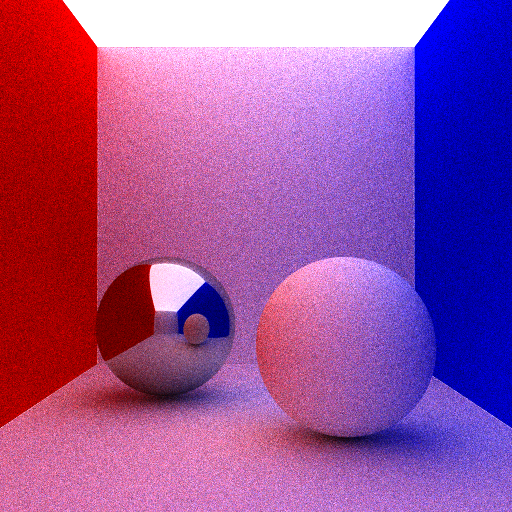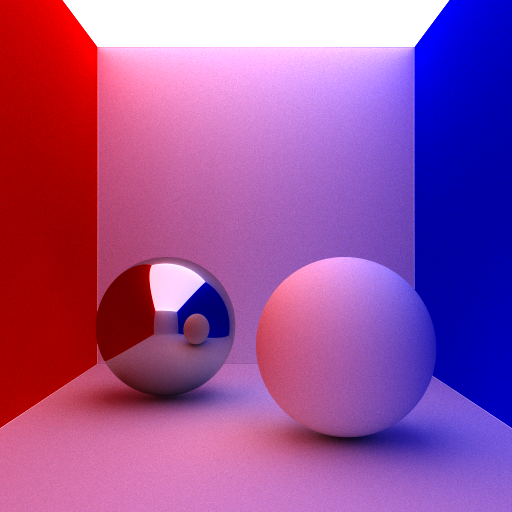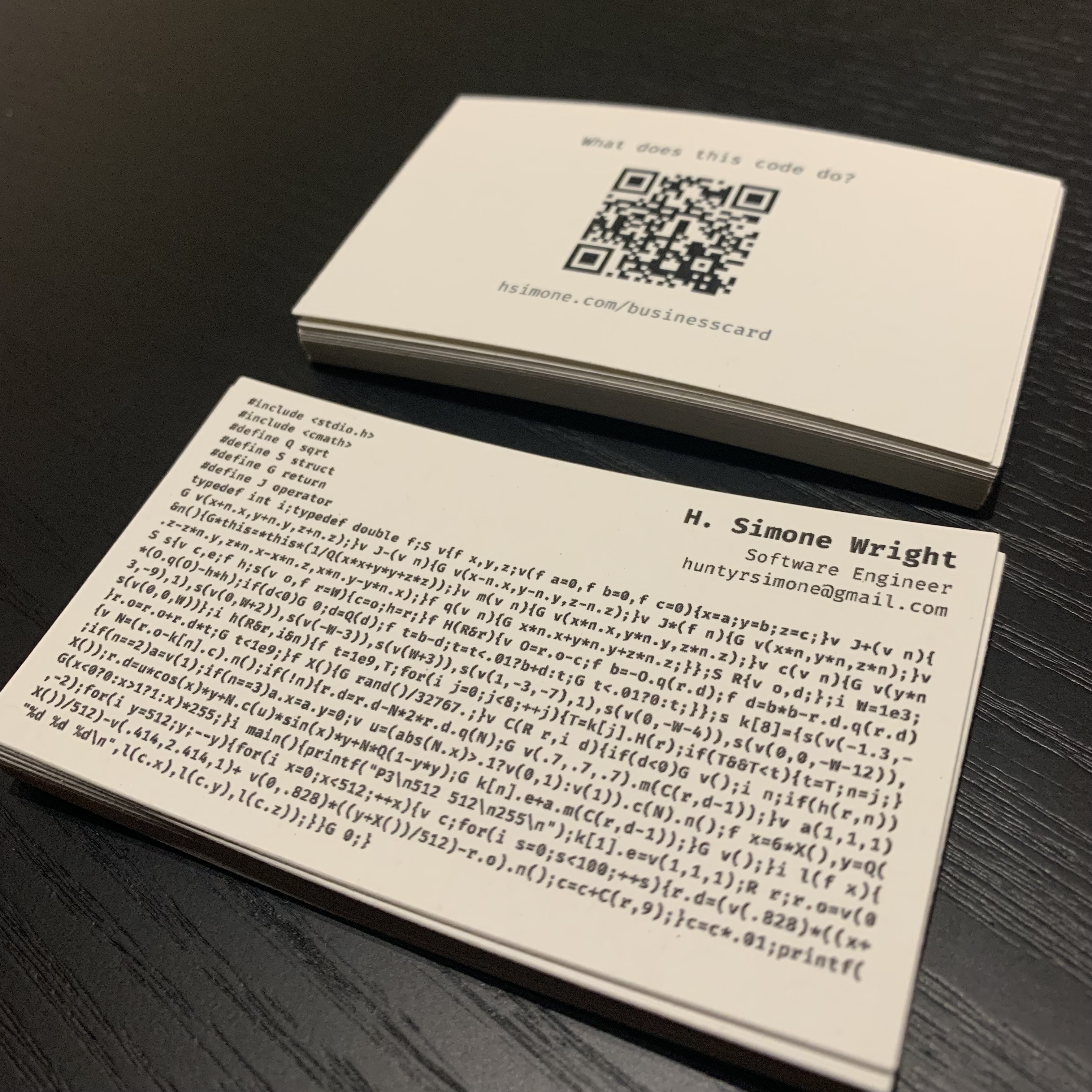Business Card Path Tracer
Intro
This was an extra credit submission for my computer graphics course in college. I remembered seeing business card ray tracers online and I wanted to give it a shot. I started by writing a simple path tracer and then condensed the code so that it could fit on a standard 3.5in x 2in business card. After many, many hours and lots of hair-pulling, I condensed my initial path tracer code into 1,444 characters. Kevin Beason's implementation of his pocket-sized path tracer smallPT helped me with this project. I highly recommend checking out his article.
My Implementation
This implementation uses Monte Carlo integration to calculate the directions of secondary rays when they hit a Lambertian (diffuse) surface.
I was only able to render spheres because it is the simplest primitive and requires the least amount of code.
The walls, floor, and ceiling are gigantic spheres and the ceiling is the emitter. Inside the Cornell Box is a diffuse sphere and a
metal sphere with no roughness. I chose these materials because I thought they would better represent the capabilities of the path tracer, such as GI
and reflections. Plus they were the easiest to render with only a few lines of code.
Here is the code. You can run it with ./card > card.ppm to save the output in a .ppm file and view the final image with this ppm viewer website.
Just note that it is very slow since it is not multithreaded and runs on the CPU.
#include <stdio.h> #include <cmath> #define Q sqrt #define S struct #define G return #define J operator typedef int i;typedef double f;S v{f x,y,z;v(f a=0,f b=0,f c=0){x=a;y=b;z=c;}v J+(v n){ G v(x+n.x,y+n.y,z+n.z);}v J-(v n){G v(x-n.x,y-n.y,z-n.z);}v J*(f n){G v(x*n,y*n,z*n);}v &n(){G*this=*this*(1/Q(x*x+y*y+z*z));}v m(v n){G v(x*n.x,y*n.y,z*n.z);}v c(v n){G v(y*n .z-z*n.y,z*n.x-x*n.z,x*n.y-y*n.x);}f q(v n){G x*n.x+y*n.y+z*n.z;}};S R{v o,d;};i W=1e3; S s{v c,e;f h;s(v o,f r=W){c=o;h=r;}f H(R&r){v O=r.o-c;f b=-O.q(r.d);f d=b*b-r.d.q(r.d) *(O.q(O)-h*h);if(d<0)G 0;d=Q(d);f t=b-d;t=t<.01?b+d:t;G t<.01?0:t;}};s k[8]={s(v(-1.3,- 3,-9),1),s(v(0,W+2)),s(v(-W-3)),s(v(W+3)),s(v(1,-3,-7),1),s(v(0,-W-4)),s(v(0,0,-W-12)), s(v(0,0,W))};i h(R&r,i&n){f t=1e9,T;for(i j=0;j<8;++j){T=k[j].H(r);if(T&&T<t){t=T;n=j;} }r.o=r.o+r.d*t;G t<1e9;}f X(){G rand()/32767.;}v C(R r,i d){if(d<0)G v();i n;if(h(r,n)) {v N=(r.o-k[n].c).n();if(!n){r.d=r.d-N*2*r.d.q(N);G v(.7,.7,.7).m(C(r,d-1));}v a(1,1,1) ;if(n==2)a=v(1);if(n==3)a.x=a.y=0;v u=(abs(N.x)>.1?v(0,1):v(1)).c(N).n();f x=6*X(),y=Q( X());r.d=u*cos(x)*y+N.c(u)*sin(x)*y+N*Q(1-y*y);G k[n].e+a.m(C(r,d-1));}G v();}i l(f x){ G(x<0?0:x>1?1:x)*255;}i main(){printf("P3\n512 512\n255\n");k[1].e=v(1,1,1);R r;r.o=v(0 ,-2);for(i y=512;y;--y){for(i x=0;x<512;++x){v c;for(i s=0;s<100;++s){r.d=(v(.828)*((x+ X())/512)-v(.414,2.414,1)+ v(0,.828)*((y+X())/512)-r.o).n();c=c+C(r,9);}c=c*.01;printf( "%d %d %d\n",l(c.x),l(c.y),l(c.z));}}G 0;}Here is a closer look at function C, which finds and returns the color of each pixel. It is a recursive function that computes the radiance of a point x given by a viewing direction.
vec3 C(Ray r, int d) { if(d < 0) return vec3(); int n; if( H(r, n) ) { vec3 N = (r.origin - objects[n].center).normalize(); if(!n){ r.direction = r.direction - N*2*r.direction.dot(N); return vec3(.7,.7,.7).multiply( C(r, d-1) ); } vec3 a(1,1,1); if (n == 2) a = vec3(1); if (n == 3) a.x = a.y = 0; vec3 u = (abs(N.x) > .1 ? vec3(0,1) : vec3(1)).cross(N).normalize(); double x = 6 * random(), y = sqrt(random()); // 2 * PI rounds to 6 r.direction = u*cos(x)*y + N.cross(u)*sin(x)*y + N*sqrt(1-y*y); return objects[n].emission + a.multiply( C(r, d-1) ); } return vec3(); }The spheres are in an array and the hit function H returns the index n of the sphere that has the closest intersection point. The function C will compute the final color of the pixel depending on the index. If n == 0, the ray intersects the metal sphere and will be perfectly reflected about the surface normal N, else it will be reflected in a random direction given by cosine sampling a upper hemisphere. If n == 2 the ray intersects the red wall and the diffuse color will be red. If n == 3 the ray hit the blue wall and the diffuse color will be blue. If none of these are true then the diffuse color will be white. This will be done d times. I decided not to add Russian Roulette for random path termination because I wanted this code to be as succinct as possible.
The hit function H is fairly simple. It determines the closest sphere that a ray intersects with and returns the index of that sphere. In this particular scene, a ray is guaranteed to hit a sphere since the camera is inside the box and the box has all 6 sides.
 100 samples per pixel
100 samples per pixel
 2500 samples per pixel
2500 samples per pixel
 My beautiful cards
My beautiful cards
This was a fun project overall. It really shows how simple the path tracing algorithm is. It also got me a few extra points on my final grade in class :D